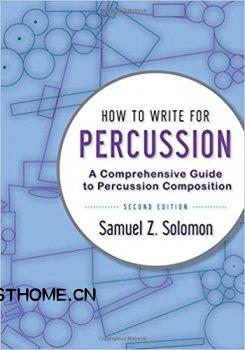P2P | PDF Book Only | 9.3MB
英文简介:
The second edition of How to Write for Percussion expands the survey of behind-the-scenes processes-from instrument choice and notation to logistics, execution, and concert production-to uncover all the tools a composer needs to comfortably create innovative and skilled percussion composition. Solomon also includes more excerpts and performances as well as interviews with famous percussionists and composers that capture the intricacies of percussion composition. Moreover, the second edition features an expanded text with more instruments and more analysis, plus an extensive Online Video Companion containing over nine hours of videos with demonstrations, performances, interviews, and analysis to flesh out and clarify the material in the book. This updated edition of How to Write for Percussionwill appeal to a wide swath of musicians including composers, arrangers, and percussionists. Those who have already utilized the first edition will welcome the upgrade, and those who have yet to benefit from Solomon’s perspective will likewise find his insights illuminating.
There are nine chapters. The first four consider issues that apply to all percussion:
1. General Framework proposes concepts for how to listen to and choose percussion instruments, and how to work with the people who play them. This chapter provides a foundation for the material in the rest of the book.
2. General Logistics explores the behind-the-scenes issues of movement, instrument choice, instrument setup, and concert production. These are often overlooked concerns that significantly influence the success of a composition.
3. General Notation details the key notational concepts for percussion writing, including guidelines for how to create parts and scores, how to set up notational systems for multi-percussion setups, and how to deal with articulation, phrasing, note length, and special effects.
4. Beaters describes each beater, its specific uses, special effects, and issues of changing beaters within a piece.
The following five chapters discuss specific types of instruments:
5. Keyboard Percussion
6. Drums
7. Metal
8. Wood
9. Miscellaneous Instruments
These chapters discuss each individual instrument. Non-keyboard instruments of determinate pitch and those of indeterminate pitch are not separated from each other, because the techniques used are not necessarily different (e.g., timpani and tom-toms).
The eight appendices expand and reinforce the concepts detailed in the rest of the book:
A. Repertoire Analysis examines in detail the percussion writing of specific orchestra, wind ensemble, mixed chamber, percussion ensemble, concerto, and solo works. Much of the material for this appendix will be found online in the form of video performances and interviews.
B. Sample Setups is a collection of instrument lists with their corresponding setup diagrams and instrument keys.
C. Extended Techniques is a catalogue of playing techniques that fall outside common practice.
D. Pitch Specification charts the appropriateness of requesting specific pitches for each of the instruments.
E. Dynamics charts the relative sounding dynamic of each instrument struck with various beaters.
F. Register charts the sounding range for each instrument.
G. Beaters charts the appropriateness of each beater.
H. Percussion Family Tree charts each instrument with respect to its pitch clarity, register, note length, and method of sound production to describe the relationships between the instruments and explain how, why, and to what degree they are different.
官网: http://szsolomon.com/write-percussion/



![French Connections: From Discotheque to Daft Punk – The Birth of French Touch by Martin James EPUB [EN]](https://audioz.download/uploads/posts/2024-09/thumbs/1727455731_407930774.webp)
![Phenomenological Investigations of Sonic Environments by Martin Nitsche, Ivan Gutierrez, Ji?í Zelenka and Vít Pokorny EPUB [EN]](https://audioz.download/uploads/posts/2024-09/thumbs/1727452129_2730555638.webp)
![Language is Music: Over 100 Fun and Easy Tips to How to Learn a Foreign Languages by Susanna Zaraysky EPUB [EN]](https://audioz.download/uploads/posts/2024-09/thumbs/1727389625_1640535344.webp)
![Cultural Sustainabilities: Music, Media, Language, Advocacy Edited by Timothy J. Cooley PDF [EN]](https://audioz.download/uploads/posts/2024-09/thumbs/1727387364_2203066536.webp)
评论0